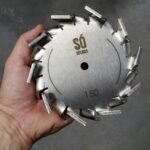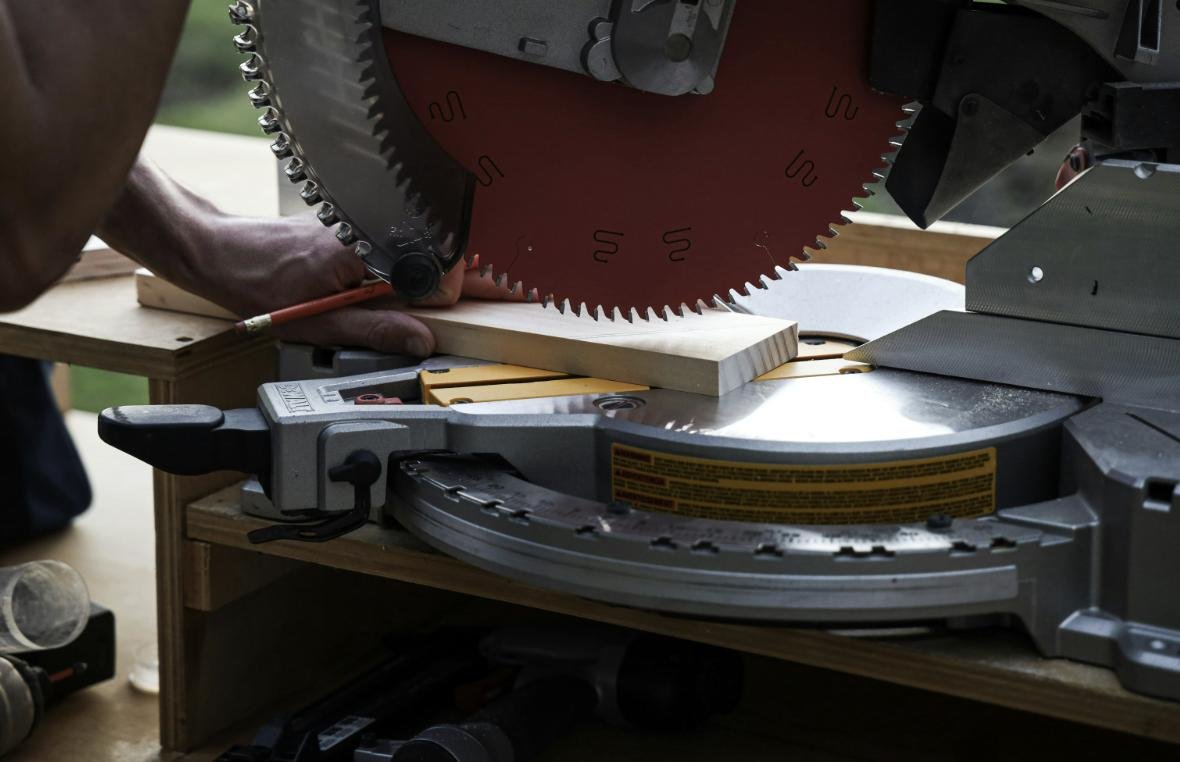Introduction to Power Saws
Power saws play an essential role in woodworking and construction, providing efficiency and precision that manual tools cannot achieve. These electrically powered devices are designed to make clean, accurate cuts in a variety of materials, such as wood, metal, and plastic. Among the different types of power saws, two of the most widely utilized are the circular saw and the table saw. Each tool offers unique features that cater to different cutting needs, making them indispensable in both professional environments and DIY projects.
The circular saw is a versatile tool, often favored for its portability and ease of use. It consists of a toothed or abrasive disc or blade that rotates to cut through materials. Circular saws are particularly advantageous for making straight cuts, allowing users to tackle everything from framing and roofing to furniture building. Their compact size and lightweight design enable them to be used in various locations, including tight spaces where larger tools might be impractical.
In contrast, the table saw is a more stationary tool that provides enhanced stability and precision for more extensive projects. It features a flat table surface on which the material is placed and a blade protruding from beneath the table, allowing users to guide the material through the cut. This design enables table saws to achieve straight, accurate cuts repeatedly, making them ideal for tasks that require uniformity, such as rip cuts and crosscuts. Both tools are essential for different applications in woodworking, and understanding their respective strengths and limitations is crucial for making informed decisions about which saw to use for specific tasks.
What is a Circular Saw?
A circular saw is a powerful hand-held cutting tool primarily used for straight cuts in various materials, including wood, metal, and plastic. The design of a circular saw features a toothed circular blade that rotates at high speeds, enabling it to slice through material with precision. Typically, the tool is compact and lightweight, which enhances its portability and makes it suitable for use in different environments, from construction sites to home workshops.
The operation of a circular saw involves the user guiding the blade through the material while applying a consistent downward force. This action generates cutting motion, allowing for a smooth and accurate cut. Most models offer different blade sizes, ranging from 4 to 7.5 inches, allowing users to choose the appropriate powerful blade for specific cutting tasks. Furthermore, the speed at which the blade rotates can also vary, with many saws featuring adjustable settings to best match the material being cut.
One of the significant advantages of a circular saw is its versatility. It can make straight cuts, cross cuts, and bevel cuts, making it ideal for projects such as framing, cabinetry, and various hobbies involving wood and other materials. A circular saw can also cut through softer metals and plastics, depending on the blade type used. However, when utilizing a circular saw, it’s crucial to follow safety guidelines. Wearing protective eyewear, maintaining a stable stance, and ensuring that the material is securely clamped can help prevent accidents and enhance the overall safety of the operation.
What is a Table Saw?
A table saw is a versatile woodworking tool used primarily for making precise cuts in various types of lumber and other materials. It consists of a circular saw blade mounted to an arbor, which protrudes through the top surface of a flat table. The design facilitates the efficient alignment of the workpiece against the blade, allowing for smooth and accurate cutting. This tool is commonly employed for ripping boards, crosscutting, and bevel cutting, making it a staple in both professional workshops and home garages.
One of the main advantages of a table saw is its ability to deliver consistent, straight cuts. The stationary nature of the table saw provides stability, enabling users to handle larger sheets of plywood or long boards with ease. By utilizing the fence and miter gauge that accompany the table saw, operators can achieve exact measurements and angles for their cuts. Additionally, many modern table saws come equipped with features like digital readouts and improved blade systems, which enhance precision and reduce setup time.
Safety is a paramount concern when operating a table saw. Most models include built-in safety features such as blade guards, riving knives, and anti-kickback pawls, which help to minimize the risk of accidents. It is essential for users to follow proper safety guidelines, including maintaining a clear workspace, using push sticks for smaller cuts, and wearing appropriate personal protective equipment. Operators should also familiarize themselves with the specific safety instructions provided by the manufacturer to ensure optimal safety during handling.
Key Differences in Design and Portability
The design and portability of circular saws and table saws significantly influence their applications, usability, and efficiency in both job sites and workshops. Circular saws, renowned for their lightweight and compact design, are equipped with a blade that rotates around an arbor, enabling them to make quick and precise cuts in various materials, including wood, metal, and plastics. Their portability is one of their key advantages; the lightweight structure allows for easy handling, making them ideal for on-site projects or locations where space is limited. Additionally, many circular saws are powered by batteries, enhancing their ease of use without the constraints of needing a nearby power source.
In contrast, table saws exhibit a design focusing on stability and precision. These saws incorporate a circular blade mounted on an arbor, which protrudes through the surface of a flat table. While they often provide more accurate cuts and enable a variety of techniques such as crosscutting and ripping, table saws are typically bulkier and heavier. This heft and the need for a dedicated workspace make them less portable than their circular counterparts. Powered primarily by electricity, table saws require access to a power outlet, which can impose restrictions on their deployment, especially in outdoor or non-traditional settings.
The differences in design and portability not only dictate the types of tasks each saw excels at but also affect user experience. Professionals in construction and renovation may prefer circular saws for their mobility and versatility. Conversely, woodworkers and hobbyists might favor the table saw’s accuracy and the ability to handle larger workpieces securely. Consequently, understanding these design differences is vital for selecting the right saw for specific projects and operational environments.
Cutting Capabilities and Precision
When comparing the cutting capabilities of a circular saw and a table saw, it is essential to evaluate the types of cuts each tool is designed to perform effectively. Both tools have distinct strengths and limitations that can influence their suitability for various woodworking projects.
The circular saw is particularly adept at making powerful and rapid cuts through thick materials. It excels in performing crosscuts and rip cuts, providing the flexibility necessary for on-site work. With a properly adjusted blade, a circular saw can also handle bevel cuts, making it a versatile choice for both straight and angled cuts. However, achieving precision with a circular saw often requires a steady hand and adequate guiding tools, such as a straightedge or a clamp, particularly when cutting sheet goods.
In contrast, the table saw is renowned for its precision and ability to make consistent, repeatable cuts. Its design allows for stable positioning of the workpiece, which enhances accuracy. Table saws are particularly effective at making rip cuts and can manage crosscuts with the right miter gauge or crosscut sled. Users benefit from the capability to adjust the height and angle of the blade easily, allowing for intricate bevel cuts and dado joints that demand high precision. This inherent stability and adjustable setup make table saws a preferred choice among professionals for tasks requiring meticulous craftsmanship.
Both saws deliver quality cuts, albeit in different contexts; the choice ultimately boils down to project requirements, material types, and desired precision levels. Understanding the unique attributes of each saw is crucial for woodworkers aiming to achieve optimal results in their cutting tasks.
Typical Applications and Use Cases
Circular saws and table saws serve different purposes in woodworking, each boasting unique advantages suitable for a range of project requirements. Understanding these applications can significantly influence the decision-making process for both home renovation enthusiasts and professional contractors.
In home renovation projects, circular saws are often the go-to tool for tasks involving cutting large sheets of plywood, framing materials, or making quick cross-cuts and rip cuts. Their portability allows for easy maneuverability, making them particularly useful for projects requiring on-site adjustments. For example, when framing a new wall or installing decking, a circular saw can efficiently handle the necessary cuts without the need for a dedicated workspace. The ability to operate in tighter spaces adds to the versatility of this tool.
Conversely, table saws shine in scenarios that demand precision and repeatability. They are ideal for producing clean, straight cuts in materials such as hardwood and plywood. When fabricating cabinetry, furniture, or trim work, a table saw’s stability and adjustable rip fence facilitate accurate dimensioning of boards, ensuring uniform pieces across a project. Professionals often rely on table saws for their efficiency in handling repetitive cuts, thereby speeding up the overall workflow in a workshop setting.
Additionally, table saws are indispensable when working on projects requiring intricate joinery or detailed finishing work. Their setup allows for advanced techniques such as bevel cuts or dado cuts, which are often crucial for achieving specific design features. This enhanced capability underscores their utility in professional construction settings where precision is paramount.
Ultimately, the choice between a circular saw and a table saw depends on the specific demands of the project at hand. Understanding the strengths of each tool can lead to more efficient workflows and superior results in both home renovation and professional construction applications.
Safety Considerations for Each Tool
When working with power tools, such as circular saws and table saws, safety should always be a primary concern. Each tool presents its own unique risks, making awareness and adherence to safety measures critical for preventing accidents and injuries. Understanding the specific precautions for each can greatly enhance the user’s safety experience.
For circular saws, which are often handheld, it is essential to maintain a firm grip on the tool while cutting. Users should ensure that both hands are on the saw, keeping fingers away from the blade’s path. The rotation design of a circular saw can lead to kickback, where the saw unexpectedly jerks back towards the user. To mitigate this risk, positioning the body to the side of the blade rather than directly behind it is advised. Additionally, it is advisable to use sharp blades and to check for any obstructions or contaminants in the material being cut, as these can increase the likelihood of kickback.
In contrast, table saws allow for more stationary work but still possess significant hazards. These saws often feature a larger blade, increasing the potential for severe injuries. Personal protective equipment (PPE) such as safety goggles, hearing protection, and dust masks are vital when operating a table saw due to the noise, dust, and debris generated during cutting. Furthermore, users should always utilize safety guards and anti-kickback devices that come with the table saw, as these features play a crucial role in preventing accidents.
Regardless of the saw type, it is crucial to keep the work area clean and well-lit to prevent tripping hazards and ensure clear visibility. Regular maintenance and inspection of both tools for any wear or damage also contribute significantly to safe operation. Adopting these best practices can help mitigate common risks associated with circular and table saws, fostering a safer environment for all users.
Cost Comparison and Budget Considerations
When deciding between a circular saw and a table saw, cost is often a primary consideration. Both types of saws cater to different needs and budgets, affecting the overall investment one must make. Understanding the price range for entry-level and professional models is essential for effective budgeting.
Starting with circular saws, the price range is relatively wide. Entry-level models can be obtained for as low as $50 to $150, making them accessible for DIY enthusiasts and occasional users. These saws typically come with essential features sufficient for basic cutting tasks. As for professional-grade circular saws, prices can escalate to $300 or more, depending on the capacity, power, and durability. High-end models often include advanced features such as laser guides and adjustable bevel settings, appealing to professionals who require precision.
In contrast, table saws tend to represent a more significant financial commitment. Entry-level portable table saws can range from $200 to $600, offering a balance of performance and affordability. However, these models may lack certain features found in more expensive options. Professional-grade table saws often fall within the $800 to $3,000 range, depending on the brand, material, and additional functionalities. These saws are designed for heavy-duty use and often come equipped with advanced safety features and enhanced cutting capabilities.
It is essential to factor in ongoing maintenance costs as part of the overall budget. Circular saws generally incur lower maintenance expenses compared to table saws, which may require more frequent blade replacements and alignment checks. Additionally, both types of saws may necessitate the purchase of accessories such as blades, safety gear, and dust collection systems, which can further impact the total cost. Tailoring your choice to your specific needs and budget will ultimately dictate the best option for your woodworking projects.
Conclusion: Choosing the Right Saw for Your Needs
Determining the optimal saw for your woodworking or construction projects requires careful consideration of various factors. Throughout this discussion, we have highlighted the primary distinctions between the circular saw and the table saw, emphasizing their respective advantages and ideal applications. The circular saw is recognized for its portability, allowing users to tackle projects on job sites or in tight spaces with relative ease. Its versatility makes it suitable for various materials, making it a preferred option for those who value mobility.
In contrast, the table saw stands out for its precision and efficiency in large-scale projects. It’s particularly advantageous for making repetitive cuts and offers a stable platform that enhances accuracy. Users who prioritize clean cuts and detailed work will find the table saw to be more beneficial, especially in a workshop setting where the workspace is less of a constraint.
When selecting between these two types of saws, it is essential to assess the nature of your projects. Consider factors such as the types of materials you will be cutting, the precision required, and your skill level. Beginners may find the circular saw easier to manage and operate, while seasoned woodworkers might prefer the advanced capabilities of a table saw for intricate designs.
Ultimately, the choice between a circular saw and a table saw will hinge on personal preferences, project specifications, and the workspace available. By taking the time to evaluate your unique needs and the specifics of the job at hand, you can make a more informed decision that aligns with your woodworking goals. This thoughtful approach will ensure that you select the right saw to achieve optimal results in your projects.






